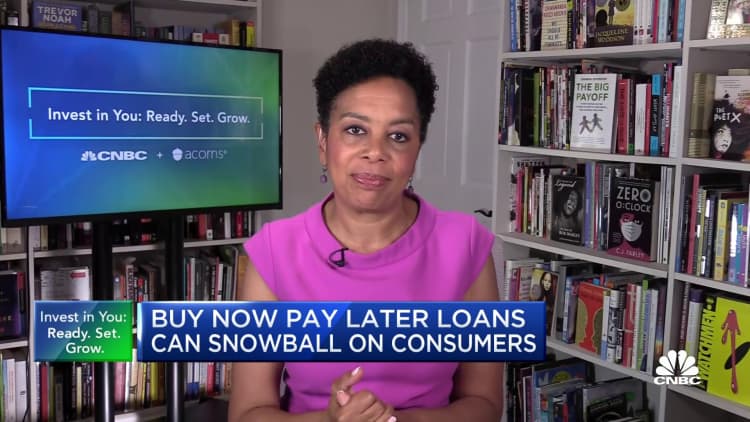Here are some strategies that can help you dig out of holiday debt
While some Americans are still recovering from holiday festivities, many others may have lingering effects of spending regrets. Overall U.S. retail sales increased 7.6% year-over-year between Nov. 1 and Dec. 24, according to the latest Mastercard SpendingPulse survey.
For many consumers, the amount of debt they took on to pay for holiday purchases grew as well. A new LendingTree study found 35% of Americans amassed holiday debt in 2022. The average amount was $1,549, the highest level since 2015 when the survey was first taken. And 37% of those taking on holiday debt said it would take them at least five months to pay it off.
If you want to pay off your holiday debt well before this summer, here are seven steps you need to take now.
1. Pay off a set amount of debt in 3 to 5 months
2. Work on improving your credit score
If your credit score is “good” to “excellent” — a FICO score of 670 or higher on a scale of 300 to 850 — you’re more likely to qualify for lower interest rates on credit cards, car loans and mortgages, experts say. So having a good score can have a dramatic impact on the cost of your debt. The more you cut the cost of the debt, the faster you’ll pay it off.
Some credit card companies will provide your credit score for free. It’s often on your billing statement. To improve your score, start by checking your credit report and disputing any errors.
Sdi Productions | E+ | Getty Images
Through the end of 2023, you can get a free weekly copy of your report from each of the major credit bureaus — Equifax, Experian and TransUnion — at annualcreditreport.com.
Of course, you should pay your bills on time every time.
Also, don’t get too close to your credit limit on your cards. Using less than 30% of your available credit can help you maintain your score, credit experts say, while using less than 10% can actually help raise that number.
3. Apply for a 0% interest balance transfer credit card
Apply for a card with an introductory 0% annual percentage rate offer on balance transfers. Transfer your current credit card balances to that new card. You may be charged a 3% fee on the amount you transfer, but you’ll pay no interest on your debt for 12 to 20 months.
“A 0% balance transfer card, if you have good enough credit to get one, is the best weapon against credit card debt,” said Matt Schulz, chief credit analyst at LendingTree. “You can get almost two years without gaining interest.”
Again, you generally have to have a good or excellent credit score to qualify for the best offers. Also, you probably won’t be able to do a balance transfer with the same card issuer.
4. Ask your credit card issuer to lower your rate
Sewcream | Istock | Getty Images
If you don’t ask for a lower rate, you won’t get it. But if you do ask, you probably will. A Lending Tree survey found 70% of people who asked for a lower interest rate on a card got one, and the average reduction was seven percentage points.
Making this phone call now is more important than ever. After seven consecutive interest rate hikes from the Federal Reserve, the average rate on a credit card is about 23%. Rates on store credit cards are over 30%.
Asking for a lower rate “is a good hedge against the Fed raising rates again and against the skyrocketing costs we’ve seen over the past year,” Schulz said.
5. Consolidate debt with a personal loan
If you can’t get a 0% offer or lower rate on a card, try applying for a personal loan. If you qualify for a big enough loan with a lower interest rate than your current card’s rate, then you can consolidate all or most of your credit card debt with that loan.
In early December, the average rate on a personal loan was 10.64%, less than half as much as the average credit card rate, according to Bankrate.com.
Just don’t spend that loan money. If you take out a personal loan to pay off credit card debt, make sure you immediately pay off your card balances with the cash from the loan.
6. Double-check the terms of buy now, pay later loans

About 1 in 10 consumers planned to use buy now, pay later loans to make holiday purchases, according to the PwC survey. You make an upfront payment with buy now, pay later products, then pay off the rest of the purchase in a predetermined number of installments.
Buy now, pay later plans often don’t charge interest unless you miss a payment. If you miss one, you could get hit with interest on the unpaid balance, as well as a late fee. So make sure you double-check the terms of the buy now, pay later offer, and comply fully.
7. Reach out to a nonprofit credit counselor
Get a comprehensive review of your financial situation and a look at your credit obligations — credit cards and loans — for free from a credit counselor. When you work with a nonprofit credit counseling agency that is part of the National Foundation for Credit Counseling, you’ll pay no fee for the initial counseling session.
“The outcome of the session results in the delivery of an action plan, identifying each possible option for improving financial well-being and managing debt,” said NFCC senior vice president Bruce McClary.
The counselor may recommend coming up with a “debt management plan” between you and card issuers or lenders to amend your original payment agreement. That plan may allow you to lengthen your repayment term, lower the interest rate, and/or waive fees. You’ll still have to pay in full, just under more manageable circumstances.
Fees are typically charged for a debt management plan, McClary said, with a program activation fee of $40 to $50 and monthly fees of $25 to $35. The cost can vary depending on the amount of debt that’s part of the plan or the number of accounts included.
SIGN UP: Money 101 is an 8-week learning course to financial freedom, delivered weekly to your inbox. For the Spanish version, Dinero 101, click here.
For all the latest Technology News Click Here

